Do you have a passion for healthy living? Do you love spreading awareness and knowledge about how to live a healthy life? Or do you perhaps have an interest in health care, but don’t want to go through years and years of medical schooling?
If so, a degree in health and wellness could be a perfect match for you. These degrees offer diverse curriculums, touching on many aspects of public health.
In this guide, we will cover the full range of degrees available in this field of study, as well as five common careers for which graduates in health and wellness are qualified.
If any of the above sounds like you, then you’ve come to the right place. A bright future working in health and wellness is waiting, so let’s get started.
What Is Health and Wellness?

A degree in health and wellness will provide a solid foundation for many aspects of public health, qualifying a graduate to work in a broad range of professions. Subjects studied in a health and wellness program could include public health, holistic health care, and wellness advocacy, as well as health care industry leadership and management, among many other topics.
This educational background can be parlayed into a broad range of careers and a wide variety of workplaces, all of which are related in some way to the health care industry and health and wellness management, which is one of the fastest-growing segments of the economy.
Emily Danckers, MS, RD, of EmilyZorn.com, studied nutrition, a health and wellness-related degree at Syracuse University.
“Obtaining a degree in nutrition helped me become a registered dietitian, which led me to create my current nutrition coaching business,” Danckers tells Online Schools Report.
“I recommend a degree in nutrition — or health and wellness in general — because everyone has to eat and most people want to be healthy. There is so much good to do in the world if you are an expert in health,” she says.
Curriculums in health and wellness programs do go beyond just nutrition. Programs can include subjects like an introduction to health care administration, how to improve the overall quality of health care, contemporary health and wellness, multidisciplinary medical practices, and aging as it relates to health care, as well as behavioral health and epidemiology.
Many health and wellness programs provide the flexibility to specialize in specific areas of the industry, while others provide a broad overview of the field, with options to explore specific interests through electives, internships, or class projects.
We’ll take an even closer look at all of this a bit later on. For now, what’s important to know is that a health and wellness student must have an overwhelming desire to help individuals and sometimes entire communities make lifestyle changes, both within the traditional health care setting and beyond.
This is a quickly growing field that provides a wide array of job opportunities. A degree in health and wellness is a ticket to a brighter future, so let’s take a closer look at just a few of the many job opportunities that await on the other side of that diploma.
Careers in Health and Wellness
Below are just some of the many careers made possible by a degree in health and wellness. Other job opportunities could include corporate wellness manager, health coach, and a health/medical writer.
No matter which career you choose in the quickly growing field of health and wellness, you’ll work closely with people, helping them improve their lives for the better.
| Job Title | Approx. # Years of Education | Average Annual Salary |
| Public Health Educator | 4 | $46,910 |
| Nutritionist/Dietician | 4 | $61,270 |
| Exercise Physiologist | 4 | $49,170 |
| Health Services Manager | 4 | $100,980 |
| Fitness Trainers and Instructors | 0 | $40,390 |
All salary data is courtesy U.S. Bureau of Labor Statistics Occupational Outlook Handbook.
Public Health Educator

Public health educators or community health workers work to educate, inform, and promote aspects of a healthy lifestyle to those within their community. They also develop and approve strategies to foster wellness, interfacing between those within the general population and health care professionals.
Public health educators work to identify, assess, and evaluate the health care needs of the people they serve. They also work to develop programs, materials, and events on health topics relevant to the public, as well as working with individuals to help them manage existing health conditions.
They may also match people with public health services, evaluate the effectiveness of public health programs and educational materials, and develop and execute training programs for other community health workers and public health professionals.
Supervision of staff can also commonly be in the job description of a public health educator, as can collecting and analyzing data about the effectiveness of specific community health programs. They also advocate for improved health resources and policies at a governmental level.
According to the Bureau of Labor Statistics, the average salary for a public health educator is $46,910 as of 2019. Additionally, there are 123,800 jobs in public health education, with an 11% growth rate expected in the years ranging from 2018 through 2028, which is much faster than the national average.
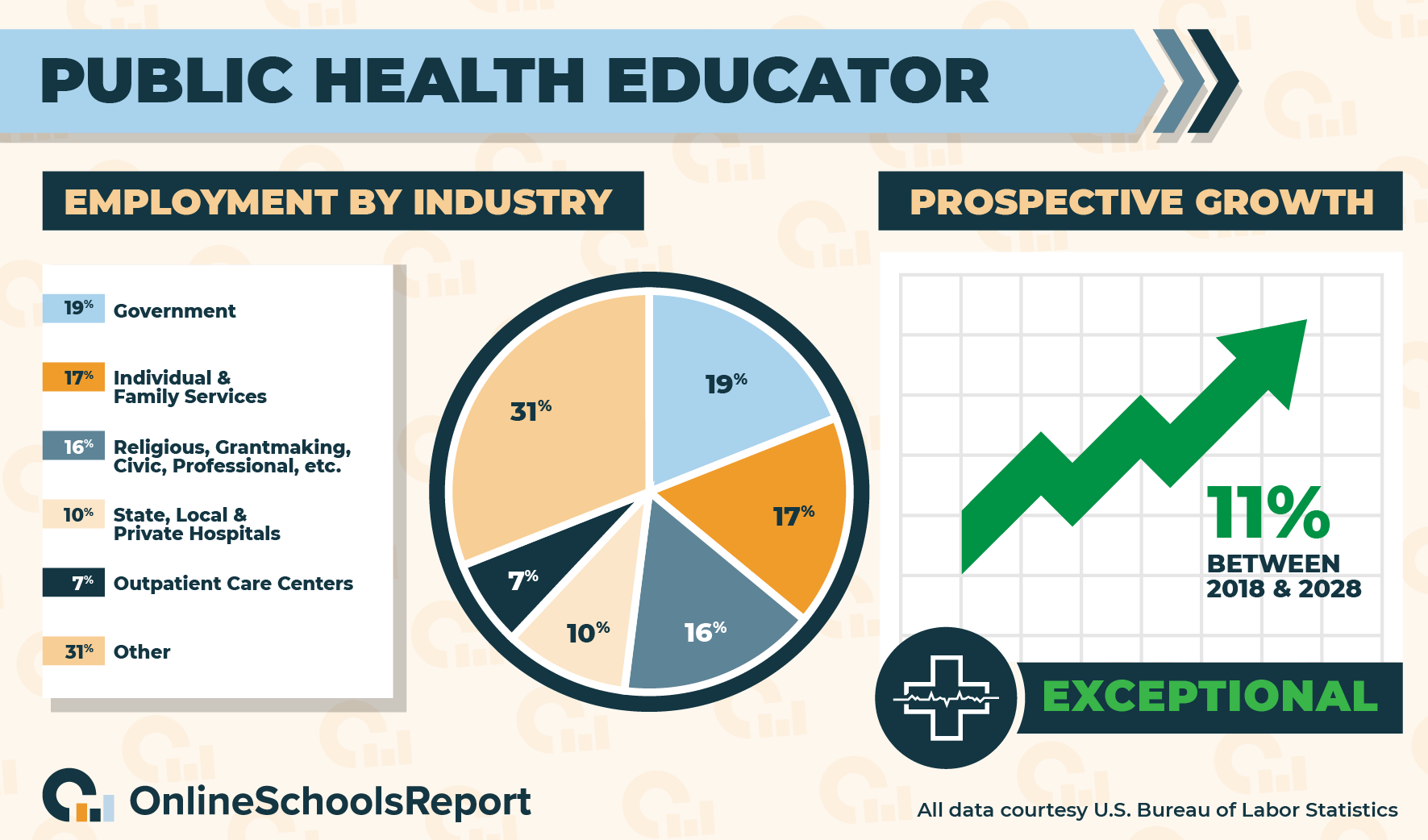
Most jobs in public health require a bachelor’s degree in health and wellness or a related field, though some require a master’s degree. It’s possible to find entry-level work with just a high school diploma or with an associate degree, though advancement opportunities and earning potential are limited. Single-year certificates in public health education are also available.
Many college graduates also go on to become a Certified Health Education Specialist (CHES) through the National Commission for Health Education Credentialing, Inc.
States with the highest levels of employment for health educators include California and New York, while states with the highest concentration of jobs in this field are New Mexico and Maryland, according to data from the Bureau of Labor Statistics.
Nutritionist/Dietician

Another common career path for health and wellness majors is that of a nutritionist or dietician. Nutritionists and dieticians work with and counsel patients and clients, assessing nutrition and health care needs, while advising patients with nutritional issues to promote healthy eating.
This can include the following: developing and evaluating the effectiveness of meal plans, as well as taking into account a patient’s preferences and any possible budgetary constraints. For example, meal planning to manage blood sugar for a client with diabetes, or a diet low in fat and sugar for a client at risk of heart disease. Nutritionists are also usually required to meticulously document their patients’ progress.
Nutritionists and dieticians also speak to large groups to promote healthy lifestyles through diet and nutrition, as well as healthy habits as a means of disease prevention. This can also include the development and creation of educational materials on the topic of healthy nutrition choices.
It’s also common for a nutritionist or dietician to contribute to up-to-date research in the field of food and nutrition science, often analyzing current dietary fads.
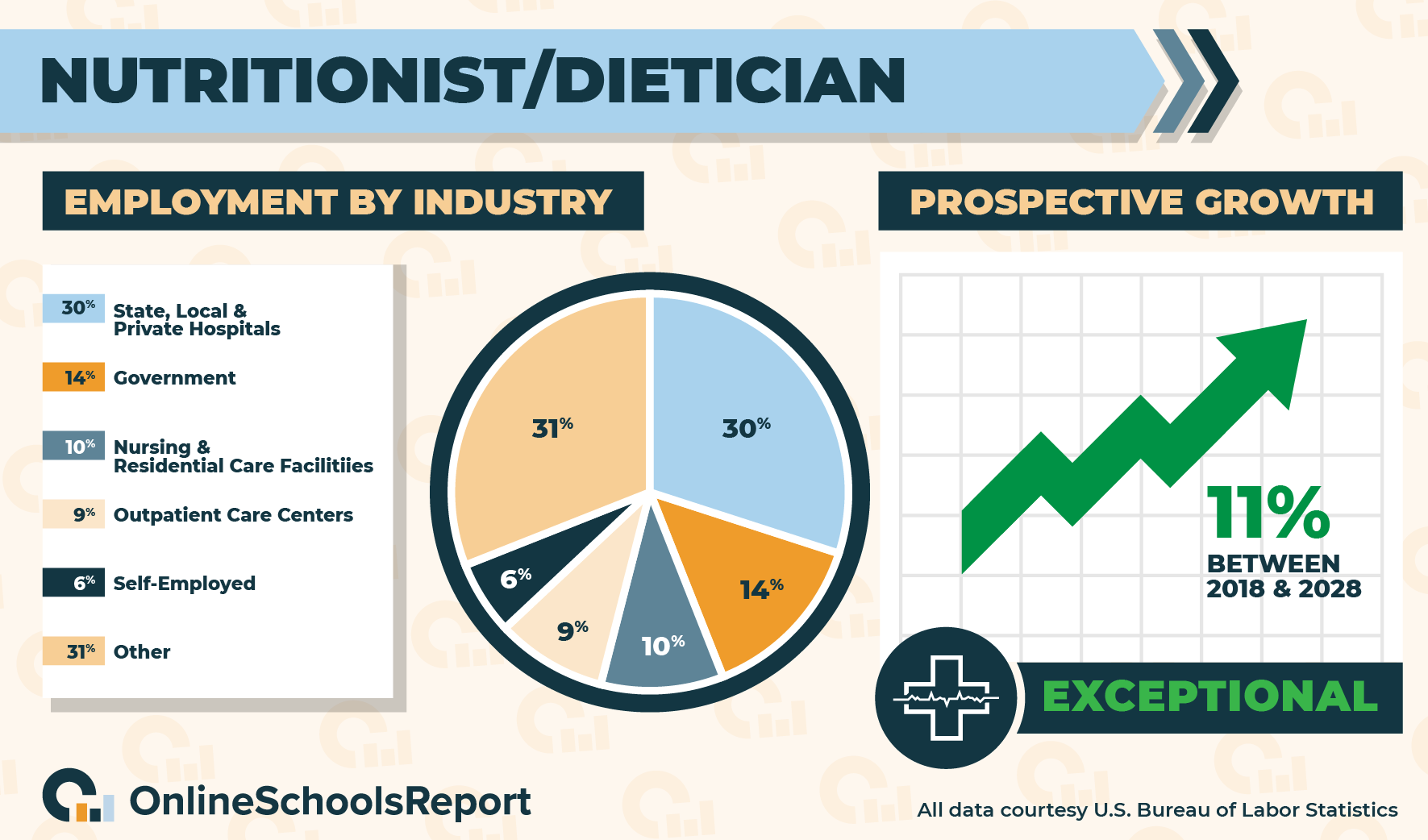
Dietitians and nutritionists can work in hospitals, clinics, or long-term care facilities. They can also own their own private practices or work for other institutions.
For example, community dietitians or community nutritionists are often employed in public health clinics, government or nonprofit agencies, and health maintenance organizations (HMOs), among other settings.
A bachelor’s degree is the minimum requirement to work as a nutritionist or dietician, with on-the-job training and residencies required for some positions. Dietitians may choose to earn the Registered Dietitian Nutritionist (RDN) credential, administered by the Commission on Dietetic Registration.
Other certifications common in the field include that of a Certified Nutrition Specialist (CNS), which requires a master’s or doctorate degree as well as 1,000 hours of supervised work experience. The certification is administered by the Board for Certification of Nutrition Specialists.
As of 2019, the average salary in this field is $61,270, according to the Bureau of Labor Statistics, with 2018 data showing 70,900 jobs in the U.S. Job growth is estimated at 11%, which, again, is much faster than average. States with high levels of employment in these professions include Texas and California.
Exercise Physiologist

Chronic disease such as cardiovascular disease or pulmonary lung disease can greatly impact the health and well-being of a patient. With an educatonal background in health and wellness, exercise physiologists are there to help, developing exercise programs that improve cardiovascular function, among other markers of a healthy body.
Working closely with primary care physicians, exercise physiologists analyze a patient’s medical history, assessing any possible risk during exercise while determining the best possible exercise and fitness regimen for the individual.
Exercise physiologists may also perform fitness and stress tests with medical equipment, analyzing the resulting patient data, which can include blood pressure, oxygen usage, heart rhythm, among other key health indicators. The end goal being to develop an exercise program to improve a patients’ health.
A bachelor’s degree is required to work as an exercise physiologist, though advanced degrees may increase employment opportunities and earning potential. According to the Bureau of Labor Statistics, the average annual salary for an exercise physiologist was $49,170 as of 2019. That’s while there were just under 16,000 exercise physiologist jobs in the U.S. as of 2018.
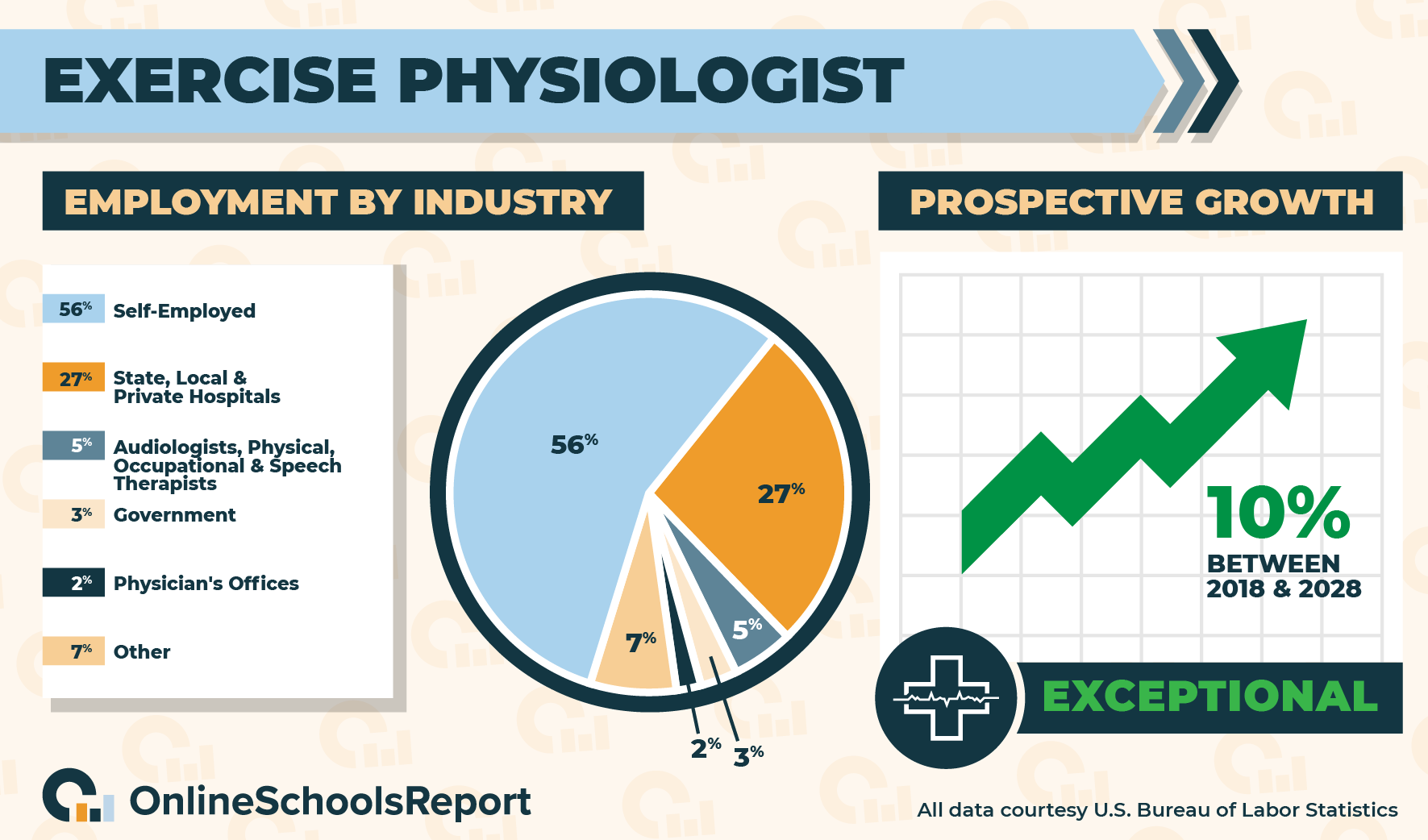
Also citing BLS data, job growth in the field of exercise physiology is expected to grow at a rate of 10% in the decade spanning 2018 through 2028, which is faster than average in many other professions.
At 56%, over half of all exercise physiologists work for themselves, according to the BLS. That’s while 27% work for state, local, and private hospitals, and 5% work in the offices of audiologists, as well as physical, occupational, and speech therapists. Three percent work for the government, and the remaining 2% work in the physician’s offices.
States with high levels of employment in exercise physiology include Michigan and California, while states with high concentrations of jobs in this field include West Virginia and Michigan. Trade organizations in exercise physiology include the American Society of Exercise Physiologists (ASEP), and the Professional Organization of Exercise Science Grads.
Additional professional resources can be found through the American College of Sports Medicine (ACSM).
Health Services Manager

A medical and health services manager, sometimes called health care executives or health care administrators, is another common career path for health and wellness majors.
No matter where they work, health services managers oversee, construct, and implement services in a wide array of health care environments, including specific clinical areas or entire medical practices.
There are three common types of health services managers: nursing home administrators, clinical managers, and health information managers.
Nursing home administrators handle admissions and finances, as well as facility and patient care. Licensing requirements vary from state to state.
That’s while clinical managers oversee specific departments, developing and carrying out policies, goals, and procedures while evaluating the quality of care. They’re also in charge of reports and budgets, as well as the maintenance and security of all patient records and data.
Health services managers are often charged with improving the efficiency and quality of health care service delivery, while working within the department to develop specific goals and objectives. Health services managers are also tasked with ensuring that facilities remain up to date and compliant with all applicable laws and regulations.
Other responsibilities of a health services manager include the recruitment, training, and supervision of staff members. Supervision can take the form of creating work schedules, as well as preparing and monitoring budgets while maintaining and organizing records.
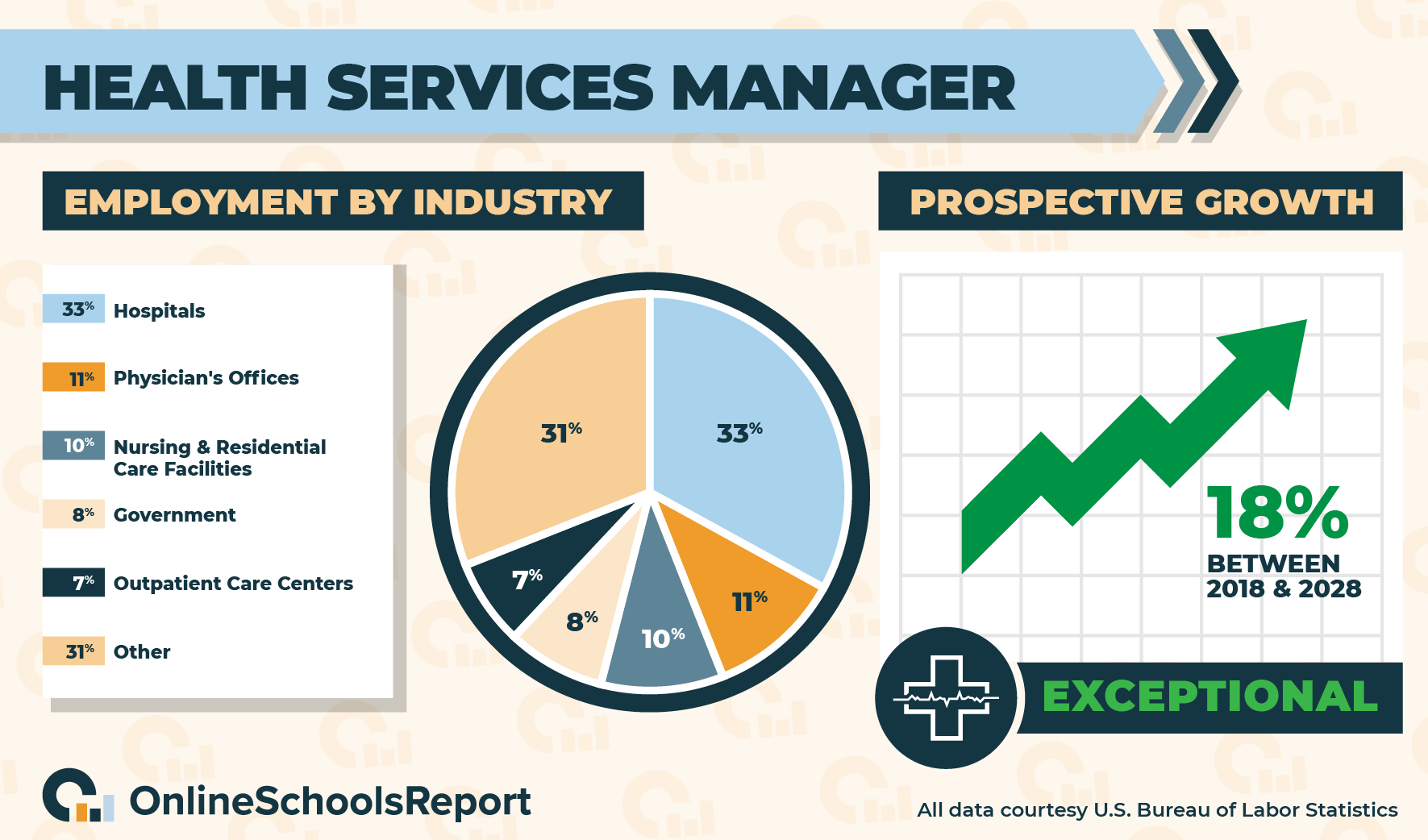
They also may represent their facility for investors or in front of governing boards, while keeping lines of communication open between medical staff and department heads.
According to the Bureau of Labor Statistics, as of 2019, health services managers make on average $100,890, with job growth in the field expected to reach 18%, which almost triples the national average. As of 2018, there were roughly 406,100 health services manager positions in the U.S., according to data from the Bureau of Labor Statistics.
States with high levels of employment in this occupation include California and Texas, while high concentrations of work in this field can be found in Arkansas and Iowa. A bachelor’s degree in health and wellness is required to work as a health services manager, though master’s degrees in health and wellness are common.
One year of supervised administrative experience in a hospital or health care consulting setting may also be required.
Fitness Trainers and Instructors

Majoring in health and wellness is also a great starting place for those interested in working as a fitness trainer or instructor. These professionals lead, instruct, and motivate individuals and groups as they exercise. They also curate and implement exercise routines for people at varying skill levels and degrees of fitness.
The types of exercises can vary, ranging from cardiovascular exercises to strength training and stretching. Fitness trainers and instructors watch to ensure clients are using the correct form while exercising, while also monitoring clients’ progress, adapting the program as needed.
They may also explain, enforce, and play a part in developing safety rules and regulations for exercises and exercise equipment.
Nutrition and diet advice, weight control, and other healthy lifestyle choices can also be under the purview of a fitness trainer or instructor. As is, on rare occasions, supplying first aid care if necessary.
There are four primary types of fitness trainers and instructors: personal fitness trainers, who work with clients and small groups in gyms or even sometimes in a client’s home; There are also group fitness instructors, who strictly work in gyms and exercise class environments.
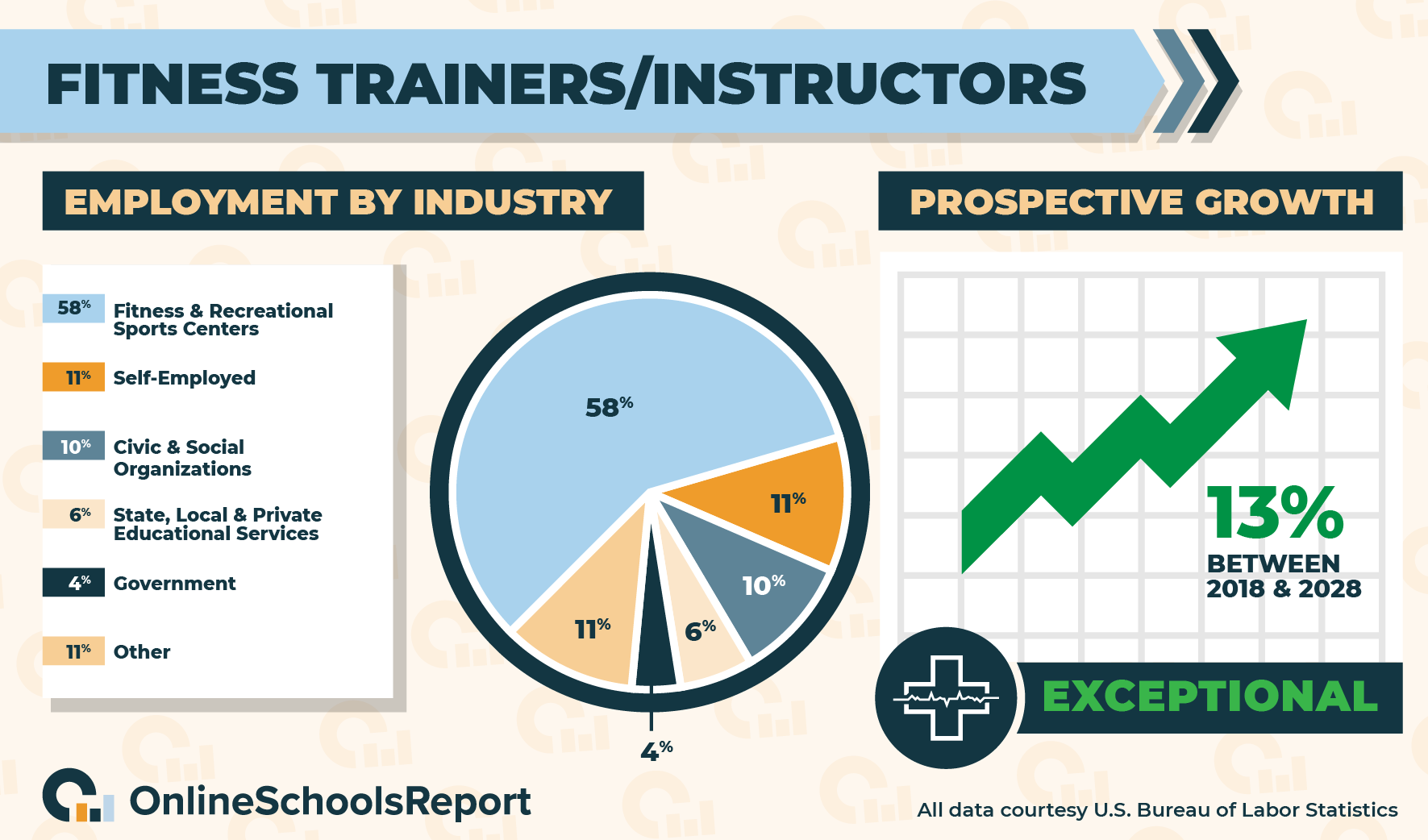
There are also specialized fitness instructors. These professionals teach specific types of exercises, like pilates or yoga.
And lastly, there are fitness directors, who oversee fitness-related aspects of a gym or health club.
A high school diploma or associate degree is commonly required to work as a fitness trainer or instructor, though advanced degrees improve career advancement opportunities and earning potential. Certification is also possible through the National Commission for Certifying Agencies (NCCA), which is part of the Institute for Credentialing Excellence.
Additional certification can also be achieved through the NASM, or the National Academy of Sports Medicine.
The average salary for a fitness trainer or instructor is $40,390. Career outlook is also strong in this field, with 13% job growth expected in the years ranging from 2018-2028, according to the Bureau of Labor Statistics.
States boasting high levels of employment for fitness trainers and instructors include California and New York, while there are high concentrations of work in this field in Colorado and Massachusetts.
Health and Wellness Degrees
Ready for a career in health and wellness? Well then, pursuing a college degree is a great place to start.
But how do you know which degree is right for you?
Here’s what you need to know about the degrees in this exciting and rewarding field. Ranging from an associate degree to a doctorate degree, each degree will deepen a student’s understanding of the subject matter while enhancing their employment and earning potential.
Associate Degree in Health and Wellness

An Associate of Applied Science degree (AAS) is the best choice for any student eager to enter the workforce as quickly, and usually as affordably, as possible. This degree will fastrack a graduate to careers in coaching, training, and advising clients in diet, fitness, and a generally healthy lifestyle outside of a clinical setting.
This degree will qualify graduates for entry-level work in a variety of settings, ranging from hospitals, private medical offices, public health agencies, and integrative health and wellness organizations and companies. The list also includes corporate wellness centers, college health services, insurance agencies, and pharmaceutical companies.
This is a great place to start for anyone seeking to become a fitness coach or trainer at a gym, for example. This degree can also be coupled with certifications to lead pilates, yoga, or aerobics classes.
Coursework in an AAS program in health wellness will cover subject matter related to stress management and emotional health, personal and community health, principles and practices of integrative health, and nutrition coaching, among many other subjects.
Graduates will also have a broad foundation in general education, and be qualified to earn several forms of certification, such as the Board Exam in Holistic Nutrition certification, offered by the Holistic Nutrition Credentialing Board.
Credits earned from an AAS degree are not always transferable to a four-year program, though many satisfy their general education requirements at the community or junior college level and go on to complete a BA in health and wellness at a college or university.
60 credits are generally required to graduate from most associate degree programs, which full-time students often complete within two years.
Bachelor’s Degree in Health and Wellness

While an AAS degree in health and wellness is a great starting point for students eager to enter the workforce, a bachelor’s degree will move students from the vocational to the theoretical, broadening their understanding of the subject matter while improving and diversifying employment opportunities and earning potential.
A bachelor’s in health wellness qualifies a graduate to work in a variety of capacities, including hospitals, public health agencies, corporate wellness centers, and more.
Graduates who earn a bachelor’s in health and wellness will be well-versed in nutrition, exercise science, health psychology, stress management, and even complementary or alternative medicine.
Graduates will be qualified to teach individuals, groups, and the broader community on similar topics, while developing administrative, ethical, and professional skills for leadership positions in the field.
120 credits are generally required to complete a BS in Health and Wellness, which commonly takes full-time students about four years. A high school diploma is required for admittance to a bachelor’s degree program, as well as ACT or SAT scores, and a minimum GPA of 2.0. Letters of recommendation or statements of intent may also be required.
The most affordable programs can be completed entirely online. Some BS programs also fast-track students to a master’s degree in health and wellness.
Many go on from a BS program to internships or to sit for exams in a broad range of certifications to further boost their employment opportunities and income potential, such as the ACE Health Coach Certification, provided by the American Council on Exercise.
Master’s Degree in Health and Wellness

A Master of Science, or MS, degree in Health and Wellness will move even further away from applied aspects of the subject matter to the theoretical, qualifying graduates to work at the management level in a broad range of health care-related organizations, furthering career opportunities and earning potential.
There are two broad areas of interest in many MS programs: a Master of Public Health, which is focused on disease prevention and health service management; there are also wellness management programs, which teaches students how to manage and lead staff in a clinic, hospital, or other health care setting.
Course topics in a Master of Public Health program can include biostatistics, public health ethics, and environmental health science, to name only a few. That’s while topics covered in a master’s degree in wellness management cover worksite wellness, organizational behavior, and exercise science, among others.
Graduates from either program frequently find employment in positions such as health communications specialist, clinical trials director, health program associate, or public health epidemiologist.
Most master’s degree programs require anywhere between 36 to 54 semester credits, or 60 to 90 quarter credits. Many students complete their coursework in two years, though some programs are designed to work around the schedule of working professionals, particularly online programs, and may take longer.
A terminal thesis is required to complete most master’s degree programs, and those interested in working in governmental public health agencies or health care organizations often move on to earn their Doctor of Public Health, or DrPH.
A bachelor’s degree in health and wellness or a related field is required to apply to a master’s degree program in health and wellness. Submitting GRE, or graduate readiness examination, scores may also be required, as well as letters of recommendation or a statement of intent.
Doctorate’s Degree in Health and Wellness

A Doctor of Public Health, or DrPH, is the highest level of education for workers in this field.
Students in a DrPH program will learn to critically evaluate public health strategies, as well as evaluating approaches to influence public health interventions and strategies. Graduates learn research methods related to public health problems, and are also taught to critically evaluate evidence-based research, as well as theories and models used in public health, among other topics.
There’s also a Ph.D. in Public Health for those interested in working in a science and research-oriented environment. Those pursuing a Ph.D. in Public Health will learn to utilize critical thinking as it relates to the practice of public health, as well as evaluating and applying population-based theories and strategies in disease and disability prevention.
They’ll also demonstrate competency in health informatics and surveillance as they relate to public health, among other disciplines.
DrPH program graduates go on to work as public health information officers, health policy advisors, and community health managers and directors, to name just a few careers made possible by this degree.
Graduates with a Ph.D. go on to work as epidemiologists, global health professionals and consultants, or public health policy advisors.
Completing a Ph.D. can take up to eight years, though most coursework, which comes in the form of seminars, workshops and some traditional classroom work, is completed in the first two years.
The remaining time is spent researching and writing a doctoral thesis, which aims to contribute new insight and thorough research in the field.
A master’s degree in health and wellness is usually required for admittance into one of these programs, and some Ph.D. programs offer a fast-track to completion for students who have already earned their master’s degree, saving students money and time.
Most Ph.D. programs require a GPA of at least 2.0, but some require GPAs that are much higher. Applicants will also need to submit their GRE score, as well as letters of recommendation or statements of intent.





